Research on the Flow Characteristics in the Gap of a Variable-Speed Pump-Turbine in Pump Mode
Abstract
:1. Introduction
2. Computational Fluid Dynamics
3. Geometric Model and Numerical Schemes
3.1. Variable-Speed Pump-Turbine Model and Parameters
3.2. Numerical Setup and Boundary Conditions
3.3. Grid Generation
3.4. Calculated Operating Conditions
4. Results and Discussion
4.1. Pressure Distribution of Internal Flow Field in Variable-Speed Pump-Turbine under Pump Modes
4.2. Internal Flow Velocity Distribution of a Variable-Speed Pump-Turbine under Pump Mode
4.3. Discussion
- (1)
- With higher rotational speed, the area of the high-pressure region before the runner inlet is significantly larger than in other operating conditions. Similarly, the area of the low-pressure region after the runner outlet is also larger than in other operating conditions. In general, as the rotational speed increases, the low-pressure area at the runner outlet gradually increases, and the high-pressure area at the runner inlet also increases. This indicates that under pump operating conditions, at lower rotational speeds, the average main stream pressure is higher than at higher speeds. Consequently, reducing the rotational speed can effectively reduce the leakage flow and decrease the volumetric losses, allowing more high-pressure fluid to enter the runner to perform work, thereby affecting the pressure distribution upstream and downstream.
- (2)
- Under pump operating conditions, with the increase in the rotational speed of the variable-speed pump-turbine unit, the changes in pressure and velocity at the crown gap are significant. Rotational speed primarily affects the internal flow field of the crown gap, with the most notable changes occurring at the inlet and outlet of the crown gap in terms of pressure and velocity. There is a significant pressure drop trend inside the gap, and as the rotational speed increases, the pressure and velocity also increase. However, as the rotational speed increases, the pressure and velocity distribution within the band gap remains almost the same. Under the condition of maximum speed, there is an observed increase in the pressure and velocity distribution at the inlet of the band gap.
- (3)
- In the three operating conditions, it can be observed that at the highest head and minimum flow rate conditions, there are phenomena that do not conform to the increase in flow velocity and pressure at the inlet and outlet of the crown gap with increasing rotational speed. At the inlet and outlet of the lower crown labyrinth seal gap, there is a low-pressure area, and the area of low-flow velocity is significantly larger compared to the higher speed conditions. This indicates that the pressure within the labyrinth seal gap and the flow velocity within the passages are also related to the head, especially in the condition of maximum head, where this particular change becomes more apparent.
5. Conclusions
- (1)
- The rotational speed significantly affects the pressure distribution, velocity distribution, and turbulent kinetic energy distribution inside the crown and band labyrinth seal gaps.
- (2)
- With higher rotational speed, the area of the high-pressure region before the runner inlet is significantly larger than in other operating conditions, and reducing the rotational speed can effectively reduce the leakage flow and decrease the volumetric losses, allowing more high-pressure fluid to enter the runner to perform work, thereby affecting the pressure distribution upstream and downstream.
- (3)
- With the increase in the rotational speed, the changes in pressure and velocity at the crown gap are significant. Rotational speed primarily affects the internal flow field of the crown gap, with the most notable changes occurring at the inlet and outlet of the crown gap in terms of pressure and velocity.
- (4)
- The pressure within the labyrinth seal gap and the flow velocity within the passages are also related to the head, especially in the condition of maximum head, where this particular change becomes more apparent.
Author Contributions
Funding
Data Availability Statement
Conflicts of Interest
References
- Zhang, F.; Fang, M.; Pan, J.; Tao, R.; Zhu, D.; Liu, W.; Xiao, R. Guide vane profile optimization of pump-turbine for grid connection performance improvement. Energy 2023, 274, 127369. [Google Scholar] [CrossRef]
- Damdoum, A.; Slama-Belkhodja, I.; Pietrzak-David, M.; Debbou, M. Low voltage ride-through strategies for doubly fed induction machine pumped storage system under grid faults. Renew. Energy 2016, 95, 248–262. [Google Scholar] [CrossRef]
- Fu, X.; Li, D.; Song, Y.; Wang, H.; Yang, J.; Wei, X. Pressure fluctuations during the pump power-trip of a low-head pump-turbine with the co-closing of guide vane and ball valve. J. Energy Storage 2023, 59, 106470. [Google Scholar] [CrossRef]
- Sarasúa, J.I.; Pérez-Díaz, J.I.; Wilhelmi, J.R.; Sánchez-Fernández, J.Á.J.E.C. Dynamic response and governor tuning of a long penstock pumped-storage hydropower plant equipped with a pump-turbine and a doubly fed induction generator. Energy Convers. Manag. 2015, 106, 151–164. [Google Scholar] [CrossRef]
- Pannatier, Y.; Kawkabani, B.; Nicolet, C.; Simond, J.J.; Schwery, A.; Allenbach, P. Investigation of Control Strategies for Variable-Speed Pump-Turbine Units by Using a Simplified Model of the Converters. IEEE Trans. Ind. Electron. 2010, 57, 3039–3049. [Google Scholar] [CrossRef]
- Shang, L.; Cao, J.; Wang, Z.; Liu, X. Hydraulic Characterization of Variable-Speed Pump Turbine under Typical Pumping Modes. Processes 2023, 11, 2903. [Google Scholar] [CrossRef]
- Shang, L.; Cao, J.; Wang, L.; Yu, S.; Ding, S.; Wei, Z.; Wang, Z.; Liu, X. Analysis of Flow and Runner Dynamic Response Characteristics under Pump Conditions of Variable-Speed Pump Turbine. J. Mar. Sci. Eng. 2023, 11, 1493. [Google Scholar] [CrossRef]
- Wanfeng, H.; Zhengwei, W.; Honggang, F. Grid synchronization of variable speed pump-turbine units in turbine mode. Renew. Energy 2021, 173, 625–638. [Google Scholar] [CrossRef]
- Guo, W.; Xu, X. Sliding mode control of regulating system of pumped storage power station considering nonlinear pump-turbine characteristics. J. Energy Storage 2022, 52, 105071. [Google Scholar] [CrossRef]
- He, L.; Zhou, L.; Ahn, S.-H.; Wang, Z.; Nakahara, Y.; Kurosawa, S. Evaluation of gap influence on the dynamic response behavior of pump-turbine runner. Eng. Comput. 2019, 36, 491–508. [Google Scholar] [CrossRef]
- Hao, Y.; Tan, L. Symmetrical and unsymmetrical tip clearances on cavitation performance and radial force of a mixed flow pump as turbine at pump mode. Renew. Energy 2018, 127, 368–376. [Google Scholar] [CrossRef]
- Koirala, R.; Zhu, B.; Neopane, H. Effect of Guide Vane Clearance Gap on Francis Turbine Performance. Energies 2016, 9, 275. [Google Scholar] [CrossRef]
- Kim, T.S.; Cha, K.S. Comparative analysis of the influence of labyrinth seal configuration on leakage behavior. J. Mech. Sci. Technol. 2009, 23, 2830–2838. [Google Scholar] [CrossRef]
- Guo, Q.; Zhou, L.; Wang, Z. Numerical evaluation of the clearance geometries effect on the flow field and performance of a hydrofoil. Renew. Energy 2016, 99, 390–397. [Google Scholar] [CrossRef]
- Kan, K.; Li, H.; Chen, H.; Xu, H.; Gong, Y.; Li, T.; Shen, L. Effects of Clearance and Operating Conditions on Tip Leakage Vortex-Induced Energy Loss in an Axial-Flow Pump Using Entropy Production Method. J. Fluids Eng. 2023, 145, 031201. [Google Scholar] [CrossRef]
- Liu, Y.; Tan, L. Tip clearance on pressure fluctuation intensity and vortex characteristic of a mixed flow pump as turbine at pump mode. Renew. Energy 2018, 129, 606–615. [Google Scholar] [CrossRef]
- Han, Y.; Tang, T.; Xiang, G.; Jia, H. A Fluid–Solid–Heat Coupling Analysis for Water-Lubricated Rubber Stern Bearing Considering the Deflection of Propeller Shaft. Appl. Sci. 2021, 11, 1170. [Google Scholar] [CrossRef]
- Kan, K.; Xu, Y.; Li, Z.; Xu, H.; Chen, H.; Zi, D.; Gao, Q.; Shen, L. Numerical study of instability mechanism in the air-core vortex formation process. Eng. Appl. Comput. Fluid Mech. 2023, 17, 2156926. [Google Scholar] [CrossRef]
- Song, X.; Luo, Y.; Wang, Z. Numerical prediction of the influence of free surface vortex air-entrainment on pump unit performance. Ocean Eng. 2022, 256, 111503. [Google Scholar] [CrossRef]
- Song, X.; Wang, Z. Numerical prediction of the effect of free surface vortex air-entrainment on sediment erosion in a pump. Proc. Inst. Mech. Eng. Part A J. Power Energy 2022, 236, 1297–1308. [Google Scholar] [CrossRef]
- Zhang, L.; Wang, X.; Wu, P.; Huang, B.; Wu, D. Optimization of a centrifugal pump to improve hydraulic efficiency and reduce hydro-induced vibration. Energy 2023, 268, 126677. [Google Scholar] [CrossRef]
- Luo, Y.; Wang, Z.; Liu, X.; Xiao, Y.; Chen, C.; Wang, H.; Yan, J. Numerical prediction of pressure pulsation for a low head bidirectional tidal bulb turbine. Energy 2015, 89, 730–738. [Google Scholar] [CrossRef]
- Qian, Z.; Wang, F.; Guo, Z.; Lu, J. Performance evaluation of an axial-flow pump with adjustable guide vanes in turbine mode. Renew. Energy 2016, 99, 1146–1152. [Google Scholar] [CrossRef]

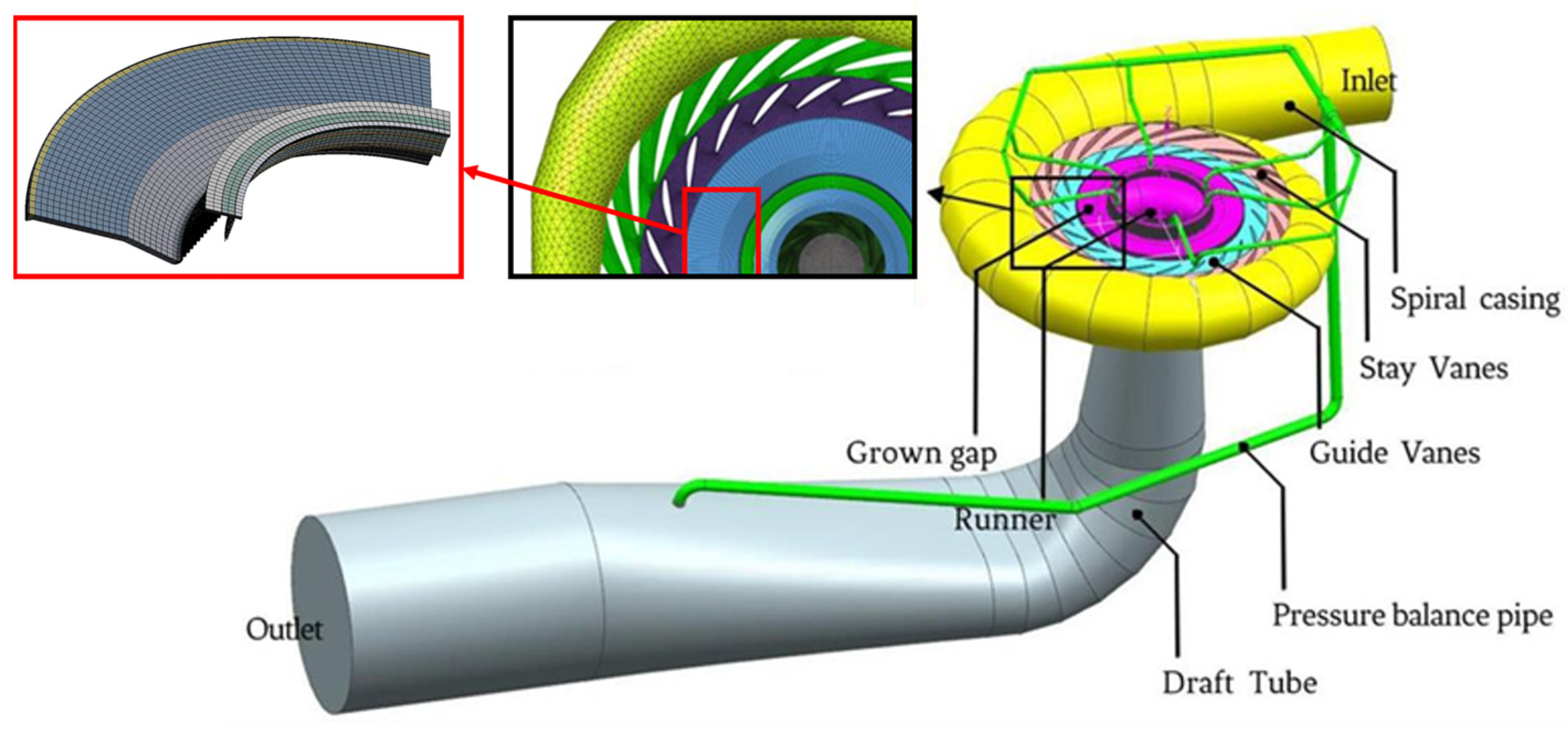
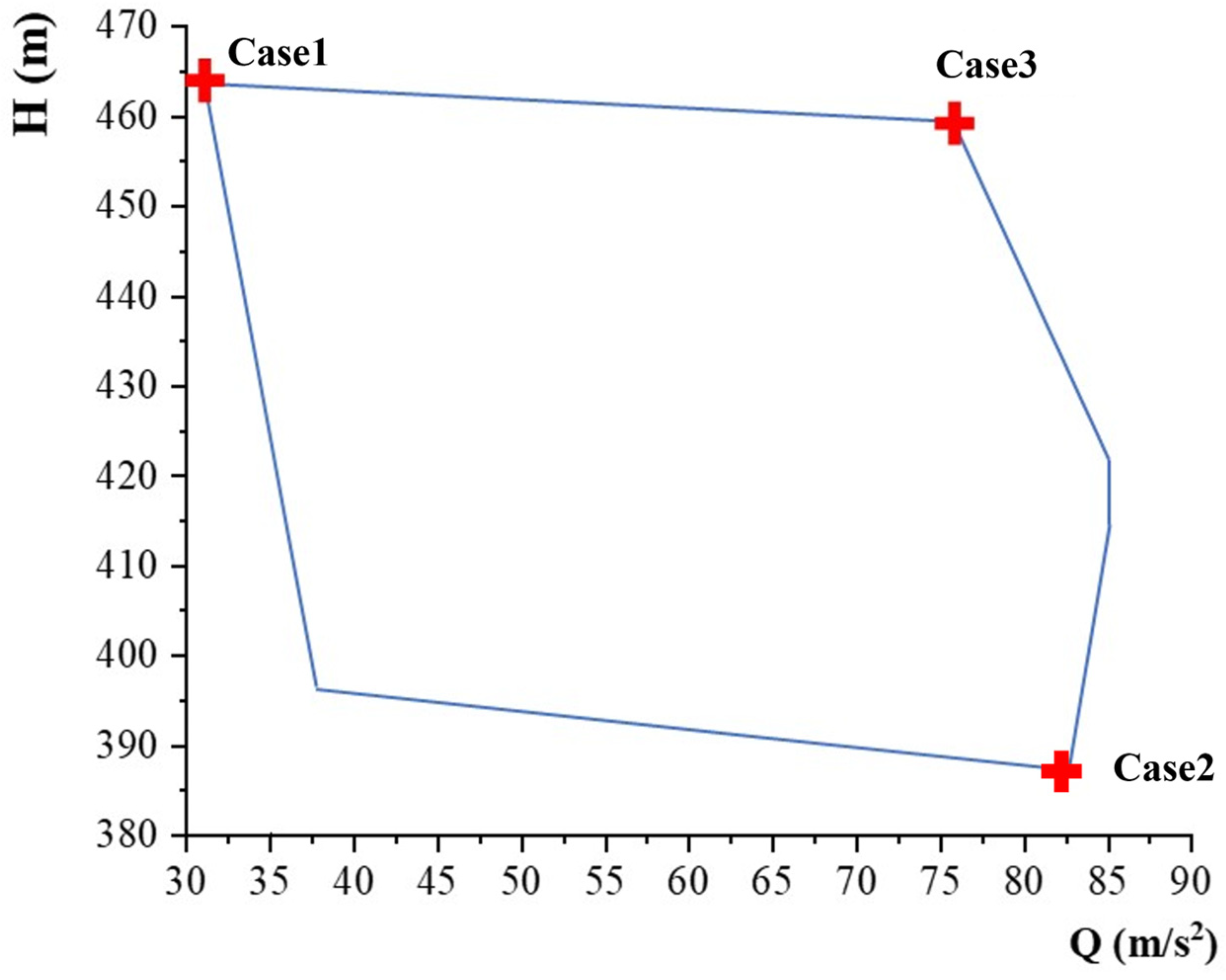
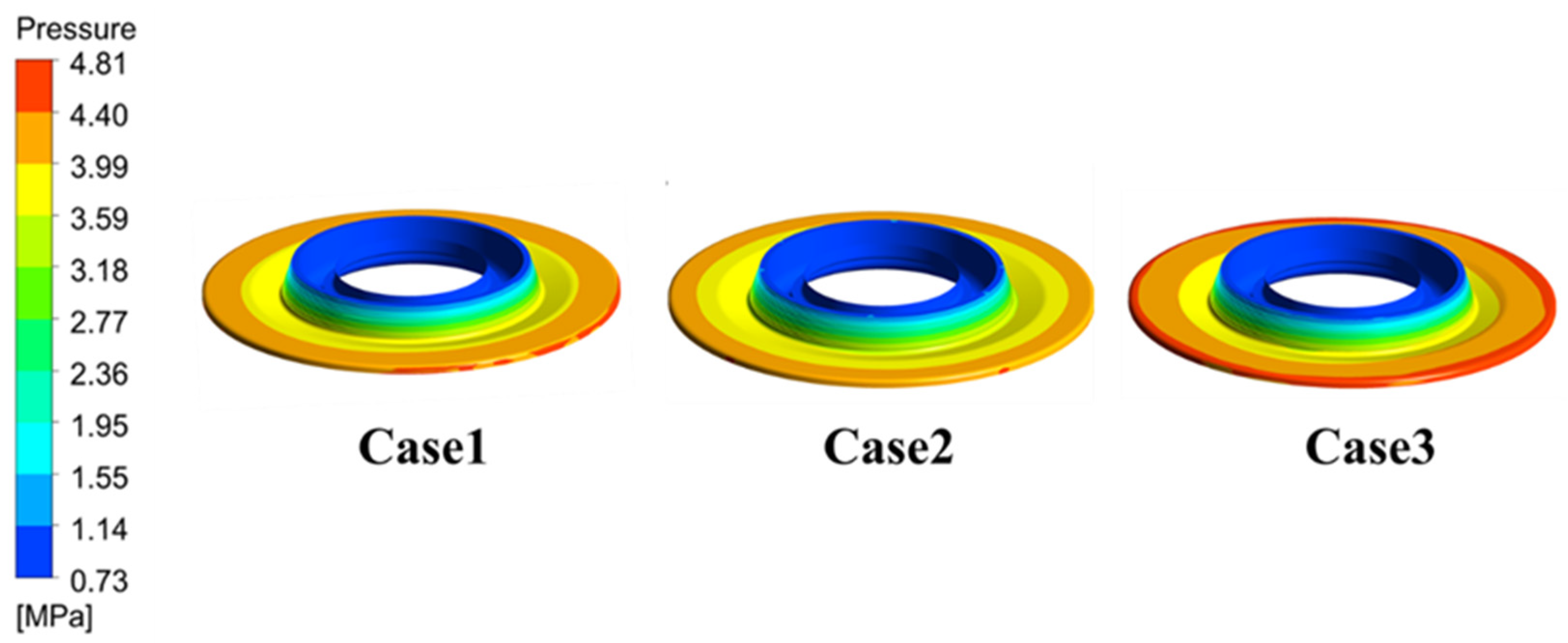

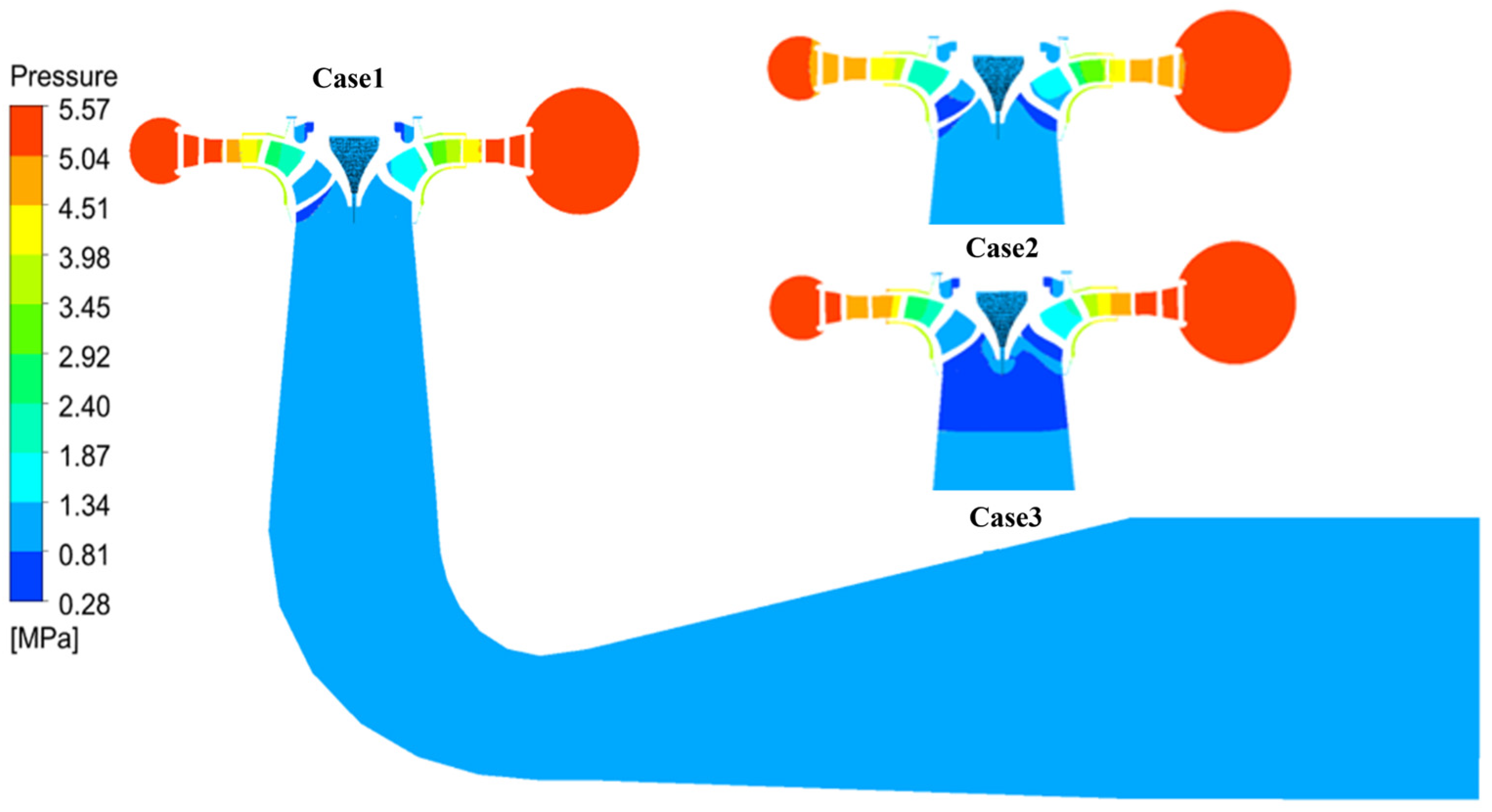
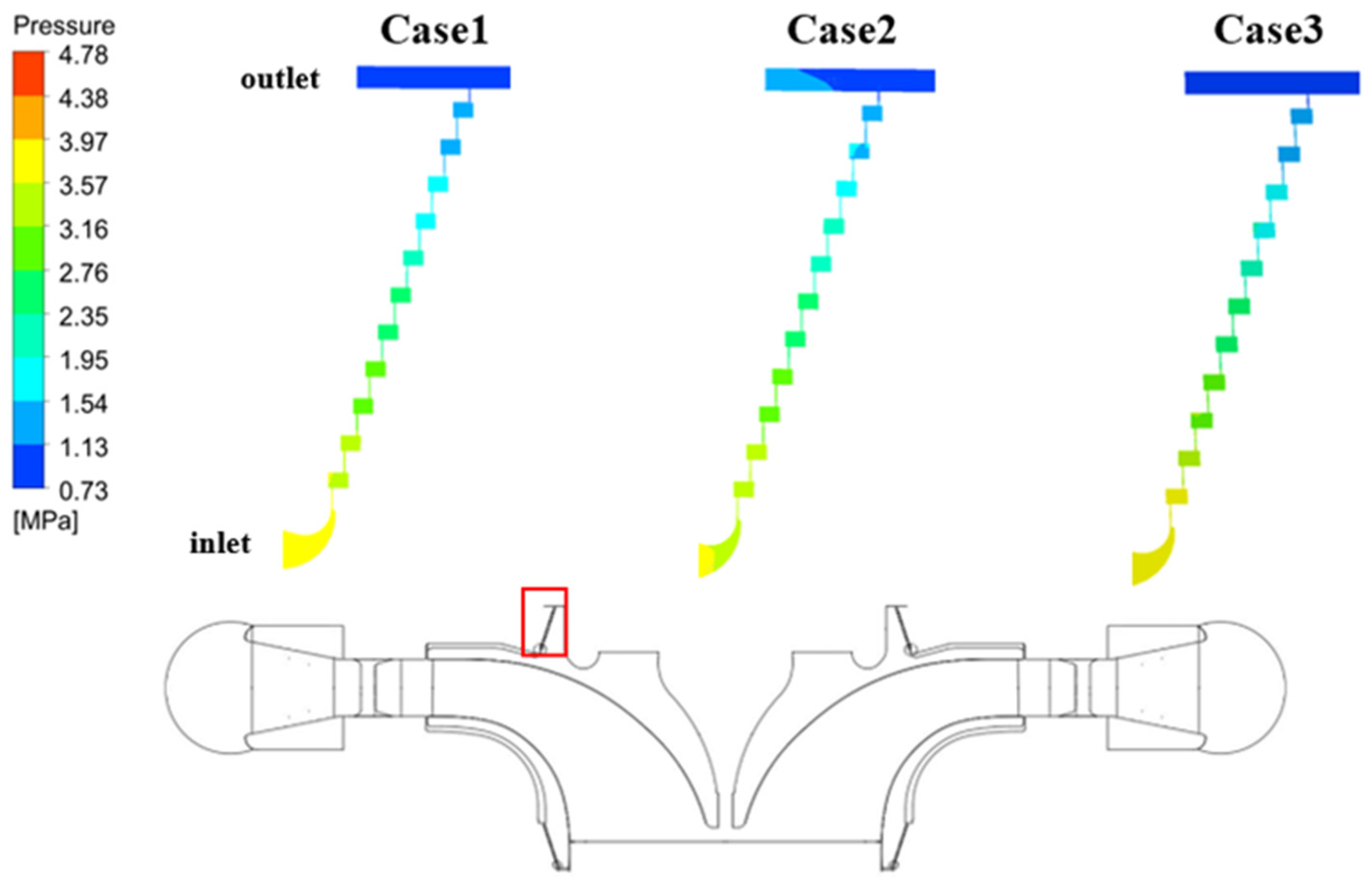
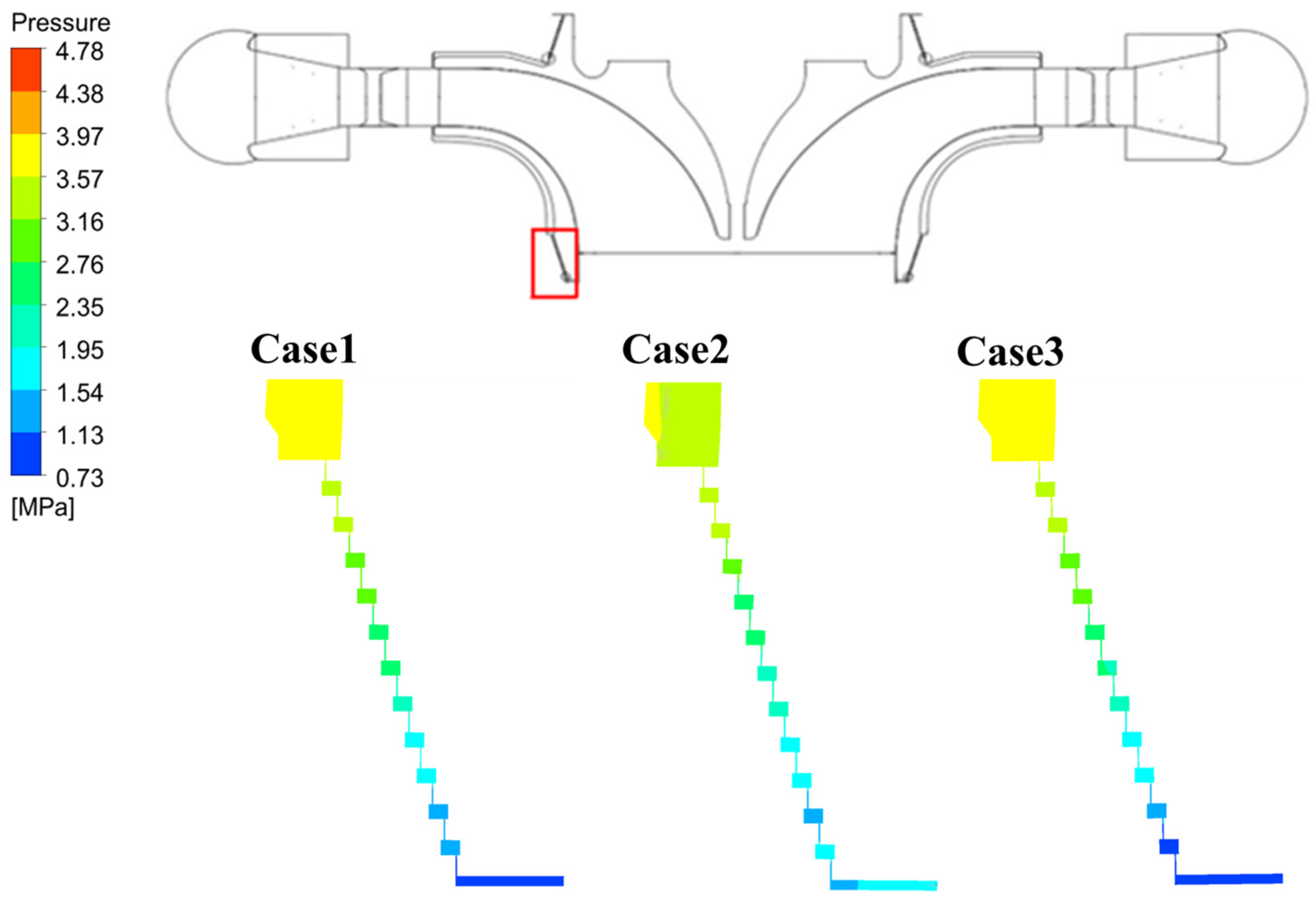

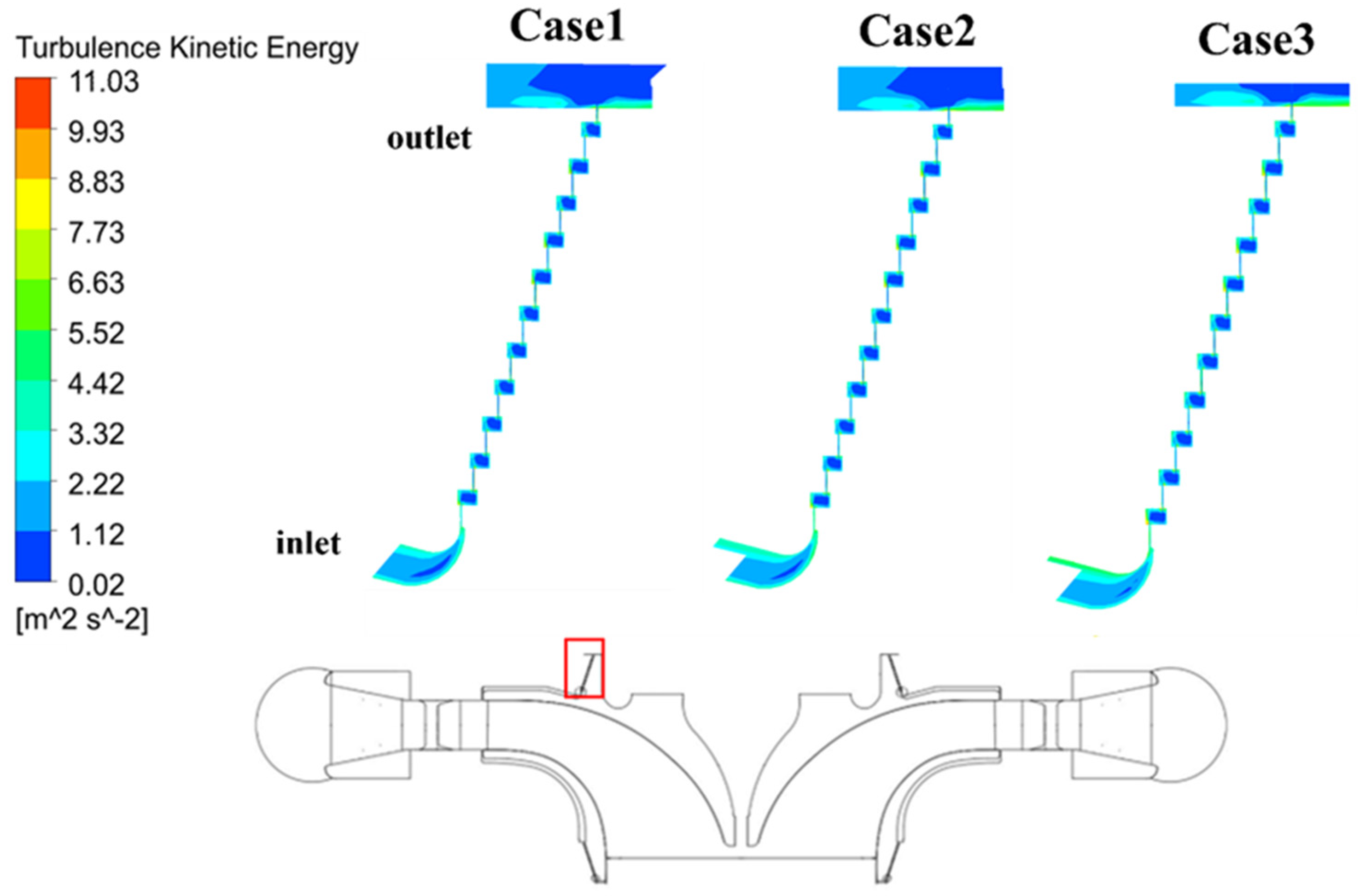
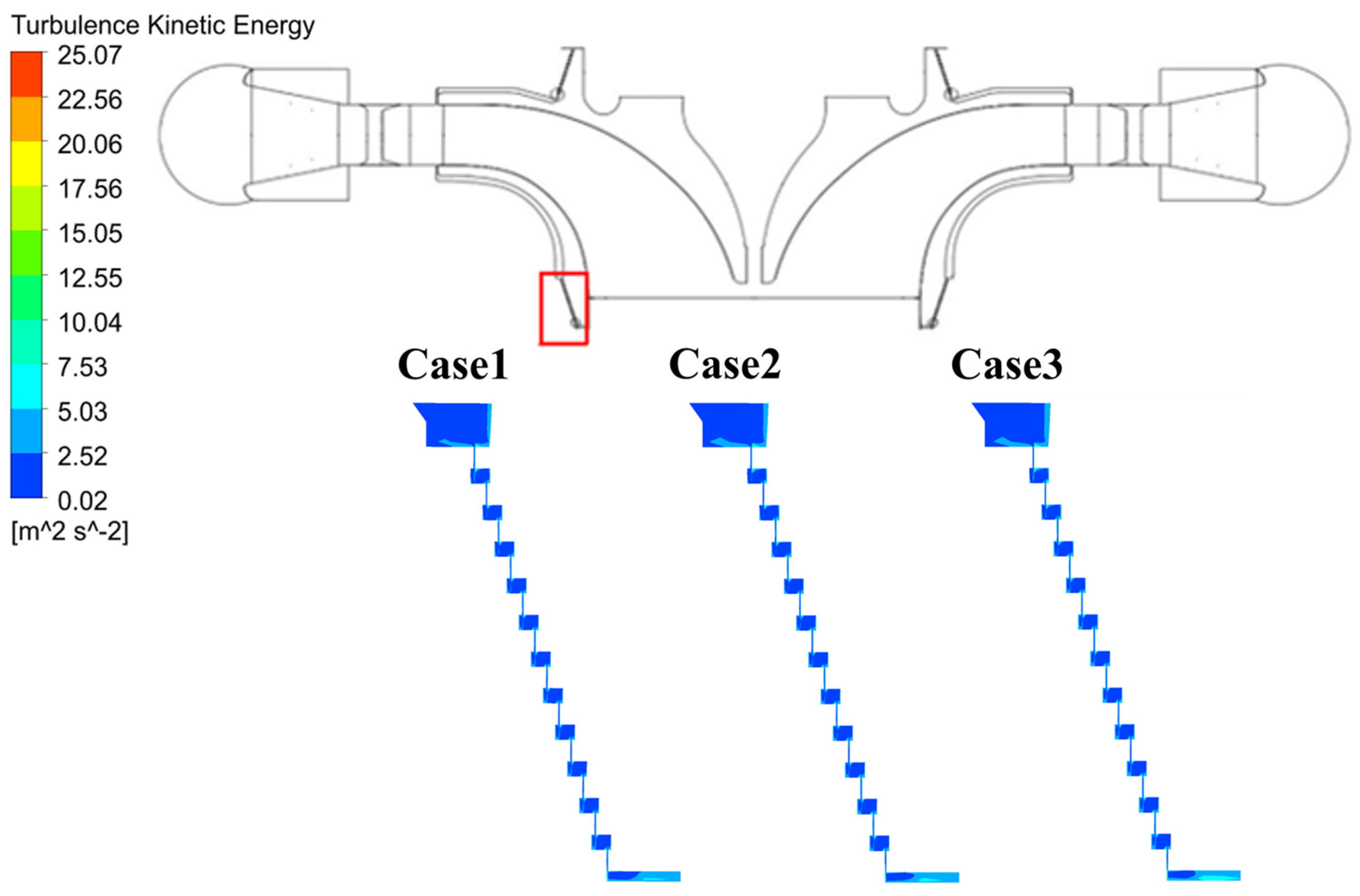
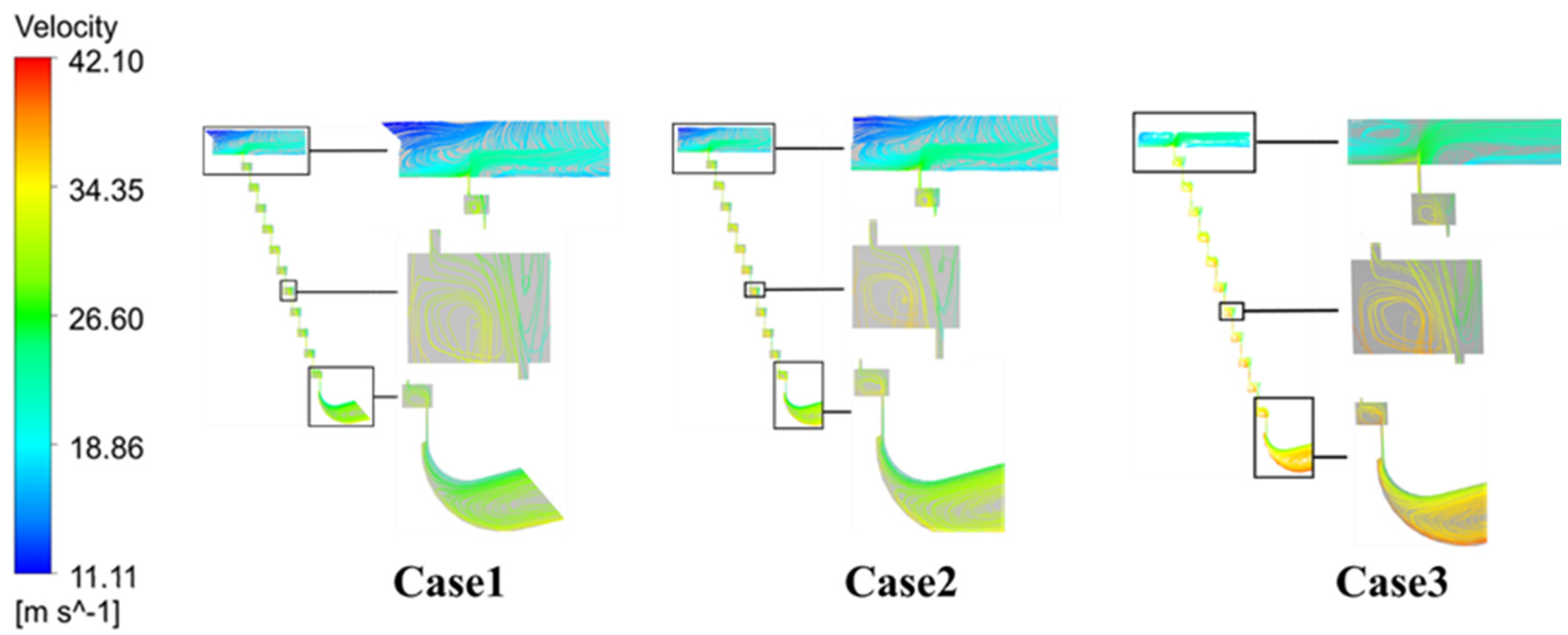

| Parameter Name | Symbols | Values |
|---|---|---|
| Impeller exit diameter | D2 (mm) | 2162.6 |
| Impeller entrance diameter | D1 (mm) | 408.4 |
| Number of impeller blades | nIM (−) | 9 |
| Number of stay/guide vanes | nSV/nGV (−) | 22/22 |
| Spiral casing exit diameter | DOUT (mm) | 2350 |
| Draft tube entrance diameter | DIN (mm) | 2197 |
| Rated head | HR (m) | 430 |
| Rated discharge | QR (m3) | 79.16 |
| Rated rotation speed | nR (r/min) | 428.6 |
| Working Conditions | Guide Vane Opening α (◦) | Speed (rpm) |
|---|---|---|
| Case1 (HMin, QMax) | 8.4 | 421.09 |
| Case2 (HMax, QMin) | 27 | 447.49 |
| Case3 (Maximum rotational speed) | 21.19 | 456.5 |
Disclaimer/Publisher’s Note: The statements, opinions and data contained in all publications are solely those of the individual author(s) and contributor(s) and not of MDPI and/or the editor(s). MDPI and/or the editor(s) disclaim responsibility for any injury to people or property resulting from any ideas, methods, instructions or products referred to in the content. |
© 2024 by the authors. Licensee MDPI, Basel, Switzerland. This article is an open access article distributed under the terms and conditions of the Creative Commons Attribution (CC BY) license (https://creativecommons.org/licenses/by/4.0/).
Share and Cite
Wang, Z.; Wang, L.; Yu, S.; Li, S. Research on the Flow Characteristics in the Gap of a Variable-Speed Pump-Turbine in Pump Mode. Processes 2024, 12, 1424. https://doi.org/10.3390/pr12071424
Wang Z, Wang L, Yu S, Li S. Research on the Flow Characteristics in the Gap of a Variable-Speed Pump-Turbine in Pump Mode. Processes. 2024; 12(7):1424. https://doi.org/10.3390/pr12071424
Chicago/Turabian StyleWang, Zhengwei, Lei Wang, Shuang Yu, and Sainan Li. 2024. "Research on the Flow Characteristics in the Gap of a Variable-Speed Pump-Turbine in Pump Mode" Processes 12, no. 7: 1424. https://doi.org/10.3390/pr12071424





